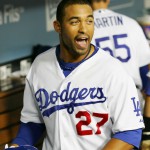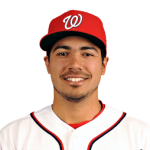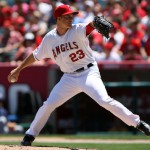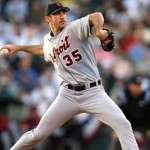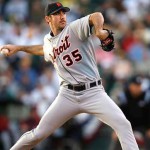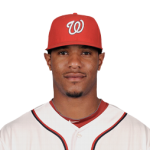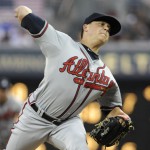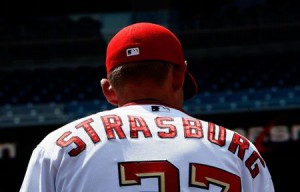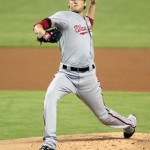
Ross Detwiler has been helping to keep the team afloat all year. Photo: Photo by Marc Serota/Getty Images
In the same spirit of grading the Minor League starters from yesterday’s post, here’s letter grades for each of the starts in April for our MLB rotation:
MLB Rotation:
- Strasburg: A,D-,A-,B-,C+,B-
- Gonzalez: A,B+,F,D,A+,D-
- Zimmermann: B,B+,A,B-,A+
- Haren: F,D,D-,C-,B+
- Detwiler: A,A-,A-,B-,C-
Discussion: Nats YTD Stats are here for reference
We’ve all been watching the games, so nothing surprising here. Jordan Zimmermann has quietly been one of the best starters in the NL so far. He’s working on a .861 WHIP and has 5 straight Quality Starts. This is reflected in his grade scores above. Meanwhile. Dan Haren‘s early struggles are slowly turning into workable outings. Ross Detwiler‘s Sunday loss was “death by paper cuts” and his 11 hits allowed wasn’t as bad as it looked in the box score. I’d like to see some more consistency out of Gio Gonzalez; is he an 8ip-1hit guy or is he 7 runs in 5 innings guy? There really hasn’t been an in-between for him. Lastly Stephen Strasburg hasn’t pitched that badly (one bad outing out of 6) but has gotten almost no run support, contributing to his ugly W/L record.
Now here’s some fun Starting Pitcher Matchup analysis. I’ve been keeping track of the opposing starter we’ve faced each night and ranked them three different ways:
- Their Rotation Order intra team: the opening day starter for a team is their “#1” and the other four guys are ranked 2-5 as they appear in the opposing rotation.
- Their Ranked Performance intra-team: at the time of their series with the Nats, the 5 starters on a team are ranked 1-5 on pure in-season performance. The guy with the best season stats at that time is ranked #1, the guy with the worst #5.
- Their Subjective League-Wide “Rank” as a pitcher: a subjective look at whether the opposing starter is a league wide “Ace,” a near-Ace or #2, and the like.
I also kept track on a night-to-night basis a quick opinion on whether I felt the Nats had the Starting Pitching Advantage (or if it was an even-matchup, or if I felt the opposing team had the pitching advantage) and tracked how we did.
Here’s some analysis based on our opposing pitcher each night. It provides some interesting insight into the team’s performance so far.
Rotation Order Stats
| Starter # | Record | Opposing Starter in Wins | Opposing Starter in Losses |
| 1 | 2-4 | Nolasco (2) | Cueto, Hudson (2), Wainwright |
| 2 | 2-3 | Slowey, Peavy | Maholm, Harvey, Garcia |
| 3 | 5-0 | Leblanc (2), Floyd, Hefner, Arroyo | |
| 4 | 1-3 | Bailey | Bailey, Sanabia, Gee |
| 5 | 3-3 | Leake (2), Axlerod | Teheran (2), Miller |
| 5+ | 0-1 | Cingrani |
In other words, the Nats are 2-4 versus opposing team’s “Aces,” 2-3 against their #2’s, etc.
(Note: a “5+” pitcher means a starter who was not on the opening day roster for a team. We’ll see a ton more 5+’s as more starters go down with injury and are replaced by minor league call-ups).
Not all #1 starters are made the same, nor are #5 starters. The team has the expected losing record against other team’s #1s, but also has a relatively weak record against other team’s #4 and #5 starters. Some of this is thanks to Haren‘s weak matchup as our #4 starter, and some of this is because guys like Homer Bailey, Shelby Miller and Tony Cingrani aren’t exactly bottom tier starters in this league (we’ll see this later on with the “League Wide Rank” table).
I initially started tracking this ranked-opposing starter analysis to prove to a friend that a team’s “Ace” doesn’t always go against another team’s “Ace.” And you can see how quickly team’s rotations get mis-matched versus one another thanks to the unbalanced schedule and irregular off-days:
| Strasburg | Three vs #1, Two vs #2, One vs #5 | |
| Gonzalez | Three vs #2, Two vs #3, One vs #1 | |
| Zimmermann | Three vs #3, Two vs #4 | |
| Haren | Two vs #4, Three vs #5 | |
| Detwiler | Two vs #5, Two vs #1, One vs #5+ |
Detwiler’s #5 rotation spot is now matched up essentially with the #1 spot of a lot of his opponents (the one #5+ spot was Cingrani, who took Cincinnati’s #1 spot from Johnny Cueto when he hit the D/L), and has been since mid April. Thankfully our #5 has been pitching like a #2 all year.
You can kind of tell what has happened to the Nats versus opponents in terms of schedule off-days just by looking at this list; clearly the Nats stayed on schedule with their opponents for at least the first three turns through the rotation, then jumped ahead a day for two turns,
Ranked Performance intra-team
| 1 | 2-3 | Nolasco (2) | Cueto, Maholm, Harvey |
| 2 | 2-1 | Peavy, Bailey | Miller |
| 3 | 2-4 | Slowey, Floyd | Hudson, Bailey, Wainwright, Cingrani |
| 4 | 4-2 | Leblanc (2), Hefner, Arroyo | Hudson, Garcia |
| 5 | 3-4 | Leake (2), Axlerod | Sanabia, Teheran (2), Gee |
In other words, the Nats are 2-3 against opposing teams’ best pitcher at the time of the series, 2-1 against the opposing team’s 2nd best performing pitcher at the time of the series, etc.
As with the above, not all #1s are the same. Ricky Nolasco is perhaps the 4th starter on a good rotation but he’s the best Miami has. Believe it or not Adam Wainwright was only the 3rd best starter on St. Louis’ team at the time of our series (behind both Jake Westbrook and Shelby Miller), despite my believing him to be an “Ace” in this league (see the next table).
League-Wide “Rank”
| Starter # | Record | Opposing Starter in Wins | Opposing Starter in Losses |
| 1 | 0-3 | Cueto, Harvey, Wainwright | |
| 2 | 1-5 | Bailey | Bailey, Hudson (2), Miller, Cingrani |
| 3 | 4-2 | Nolasco (2), Peavy, Floyd | Maholm, Garcia |
| 4 | 1-0 | Arroyo | |
| 5 | 7-4 | Slowey, LeBlanc (2), Axelrod, Leake (2), Hefner | Sanabia, Gee, Teheran (2) |
In other words, the Nats are 0-3 against MLB “Aces,” 1-5 against MLB “near aces” or #2’s, etc.
This table really shows how the team has truly done against the elite pitchers in this league. We can argue in the comments section about my subjective ranking of pitchers (is Matt Harvey truly an “Ace” in this league? Probably not yet, but he sure is pitching like one. Is Julio Teheran really a #5 pitcher in this league? Not on talent, but certainly on performance thus far), but I’m happy with my rankings for pitchers overall.
For comparison purposes with our own team talent-wise, I have Strasburg as a league-wide #1, Gonzalez and Zimmermann as #2s, Detwiler as a #3 (but rising) and Haren as a #4 (but falling; he was a #2 just a couple years ago).
The Nats have managed just one victory over Aces or near-Aces in this league so far (and that was by virtue of Zimmermann‘s one-hitter victory over Homer Bailey: you don’t win 1-0 games in the Majors very often). They’re 12-6 against everyone else.
The team’s bigger concern should be games dropped to the #5 pitchers. For every loss to an Ace, you have to make up for it by beating up on the lesser starters in this league. You just cannot lose to guys like Alex Sanabia or Dillon Gee.
Performace against Expectations by Advantage
| By “Advantage” | Record | Matchups in Wins | Matchups resulting in Losses |
| Wash | 10-6 | Stras-Hudson, Stras-Garcia, Haren-Sanabia, Zimm-Gee, Detwiler-Teheran, Stras-Teheran | |
| Even | 3-6 | Zimm-Bailey, Detwiler-Nolasco, Haren-Leake | Stras-Cueto, Stras-Harvey, Detwiler-Wainwright, Detwiler-Cingrani, Gonzalez-Hudson, Gonzalez-Maholm |
| Opp | 0-2 | Haren-Bailey, Haren-Miller |
In games where I thought Washington had the clear starting pitching advantage head-to-head, we still managed to lose 6 times. Those losses are listed above: three times we dropped games where Strasburg was pitching against lesser opponents. You can quibble whether Strasburg-Tim Hudson is an even matchup or not, but certainly Strasburg vs Teheran or Jaime Garcia is a mis-match on paper.
In games where I thought the pitching matchup was even, the team still went just 3-6. Again, Strasburg ended up with some tough matchups against other fellow “Aces,” while Detwiler ran into a couple of hot-hands.
The two games where I thought our opponent had the clear advantage heading into the game both involved Haren going up against near-aces from Cincinnati and St. Louis; we lost both games easily as expected.
April Conclusion: The Nats have faced some good teams with some good pitching thus far; they need to do a better job cleaning up against opposing teams’ #5 starters.
This analysis doesn’t even start to look at the offense; with better run support Strasburg may be 4-1 instead of 1-4. And it doesn’t look at the bullpen or our defense of course; two areas that have turned Wins into Losses pretty quickly for the team.
